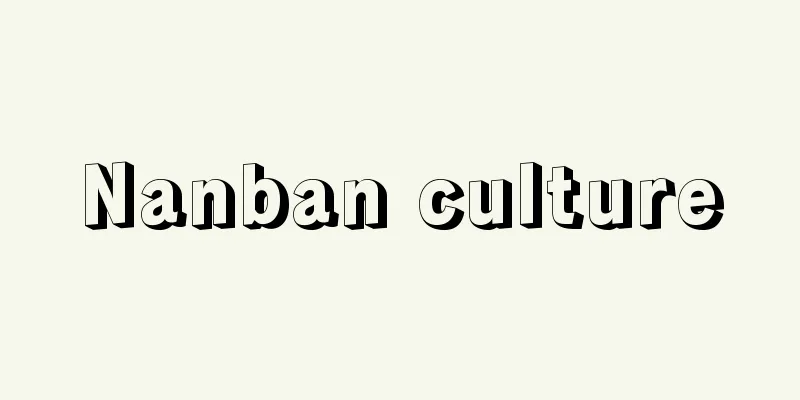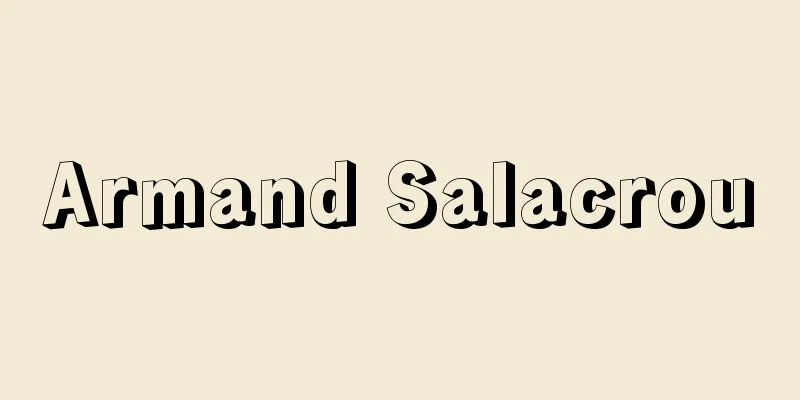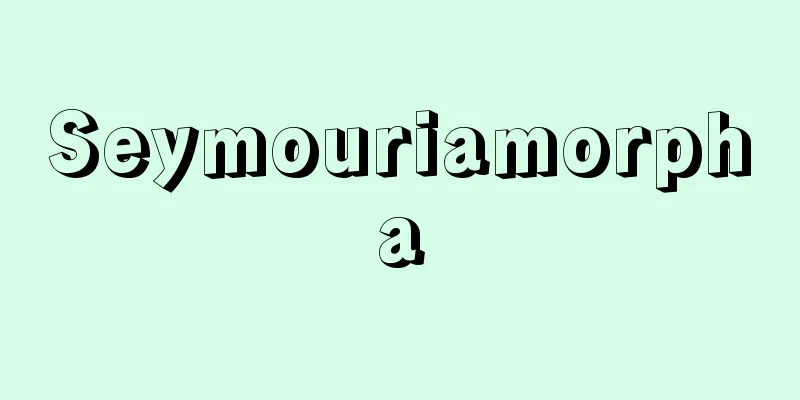Nanban culture

|
This is a foreign culture that spread when Catholic people from southern Europe came to Japan in the 16th and 17th centuries, and was also influenced by the Japanese. Some people call it Kirishitan culture, but although this is an appropriate name for the Christian-related aspects of Nanban culture, there were many foreign cultural artifacts that were not directly related to the Christian sect, such as castella cakes, jiban (undergarments), and tobacco. Also, while Christian culture was strictly prohibited during the Edo period, Nanban culture, which was unrelated to religion, was readily accepted, so it can be said that the nature of the two is quite different. In the field of art, the "Nanban folding screen" can be mentioned. In the narrow sense, it refers to "folding screens depicting the arrival of Nanban people," and the theme is the port town of Nagasaki from the late 16th century to the early 17th century, with the left half of the pair depicting foreign scenes. Nanban ships, Nanban merchants, Christian churches and missionaries are indispensable elements of this type of folding screen. In a broader sense, it also refers to folding screens depicting maps of Japan and the world, folding screens depicting Western customs and customs, and folding screens depicting world cities. It is clear that folding screens depicting cities were based on art books brought to Japan from Europe. In addition to folding screens, there are many Christian religious paintings, such as portraits of Xavier and statues of the Virgin Mary, as well as a large number of so-called "Nanban things," non-religious arts and crafts, such as lacquerware, pottery, and metalwork. As for customs, there are foods such as tempura, castella, bolo (bowls), bread, and konpeito (candy), clothing items such as meriyasu, rascha (rasha), sarasa (chintz), jiban, and velvet, and others that are presumed to have been brought over from Nanban based on the terms used, such as tobacco, karuta, and vidro. However, it is not enough to say that something is a product of Nanban culture just because the same term exists in Portuguese. Unless it is confirmed that it was widespread in Japan before the early Edo period, it cannot be said to be a product of Nanban culture. Some of the things mentioned above cannot be said with certainty in that sense. The custom of eating meat originated in Nanban, but it did not become widespread, and Western music and theater also disappeared with the prohibition of Christianity. One notable aspect of Nanban culture was the schools run by the Jesuits, where Christian books were published. However, these did not become widespread or developed due to the suppression of Christianity. As negotiations with the Dutch continued, Nanban medicine, astronomy, firearms, and other fields were linked to Rangaku (Dutch studies), and were accepted and developed by the Japanese in each field. In addition to the above, we should not overlook the contributions made by Nanban missionaries to Japanese society, such as providing relief to refugees during times of war and widely preaching Christian morality. [Takeichi Matsuda] "Outline of Christian Culture by Ebisawa Arimichi (1948, Seinen Hyoronsha)" ▽ "Nagasaki City History: Manners and Customs, edited by Koga Jujiro, reprint (1967, Seibundo Publishing)" ▽ "Research on the Nanban Academic Lineage, by Ebisawa Arimichi, expanded edition (1978, Sobunsha)" Source: Shogakukan Encyclopedia Nipponica About Encyclopedia Nipponica Information | Legend |
|
16~17世紀に南ヨーロッパのカトリック教国民が日本にきたことによって普及し、また日本人がその影響を受けた外来文化。キリシタン文化の名でよぶ向きもあるが、これは、南蛮文化のうちキリスト教関係のものについての名称としては適切であっても、キリシタン宗門と直接関係のない外来の文物、たとえばカステラ、ジバン(襦袢(じゅばん))、タバコなども多く、またキリシタン文化は江戸時代に厳禁された一方、宗教と無関係の南蛮文化は好んで受容されたから、両者の性格は相当異なっているといえよう。 芸術の分野では「南蛮屏風(びょうぶ)」をあげうる。狭義には「南蛮人渡来図屏風」をさし、16世紀末~17世紀初頭の長崎の港町が主題で、左半双には外国の情景を描いたものもある。この種の屏風では、南蛮船、南蛮の商人、キリシタンの教会と宣教師たちが欠かせない要素となっている。広義には、世界・日本地図屏風、西洋風俗図屏風、世界都市図屏風などをもさしている。都市図屏風などが、ヨーロッパから日本にもたらされた画集などに基づいていることは明らかである。屏風以外にも、ザビエル肖像画、聖母マリア像など、キリシタンの宗教画も多く、そのほか漆器、陶器、金工など、宗教色のない美術工芸の、いわゆる「南蛮もの」が数々みいだされる。 風習としては、テンプラ、カステラ、ボーロ(ボウル)、パン、金平糖(こんぺいとう)のような食品、メリヤス、ラシャ(羅紗)、サラサ(更紗)、ジバン、ビロードのような衣服関係のもの、そのほか、タバコ、カルタ、ビードロなど用語から南蛮渡来のものと推定されるものがあるが、ポルトガル語に同じ語句があるからという理由だけでは不十分で、江戸初期以前から日本で普及していたことが確認されなければ、南蛮の文物とはいえない。既述のもののなかにもその意味では断定できないものもある。肉食の風習は南蛮に由来するが、普及せず、西洋音楽、演劇もまたキリシタン宗門の禁止とともに消滅した。南蛮文化のうち特筆に値するのはイエズス会経営の学校であり、キリシタン版の刊行もそこで行われた。しかしそれらもキリシタンの禁圧によって普及発達しなかった。南蛮医学、天文学、銃砲などは、オランダ人との交渉が継続したので、蘭学(らんがく)へとつながって、日本人がそれぞれの分野で受容し発達せしめた。以上のほか、南蛮人宣教師が戦乱の時代に難民を救済したり、キリスト教的道義を広く説くなど日本社会に貢献したことも看過すべきではない。 [松田毅一] 『海老沢有道著『キリシタン文化概説』(1948・青年評論社)』▽『古賀十二郎編『長崎市史 風俗編』再版(1967・清文堂出版)』▽『海老沢有道著『南蛮学統の研究』増補版(1978・創文社)』 出典 小学館 日本大百科全書(ニッポニカ)日本大百科全書(ニッポニカ)について 情報 | 凡例 |
Recommend
Battle of Kurikara Pass - Battle of Kurikara Pass
It is also called the Battle of Tonamiyama. It is ...
Crime novel
…In Japan, the term “mystery” is also used, but i...
Tsugishikishikishi
A fragment of a collection of poems copied in the...
Kajita Hanko - Kajita Hanko
Year of death: April 23, 1917 Year of birth: 25th ...
Battle of Leuctra - Battle of Leuctra
The Battle of Sparta and Thebes in 371 BC. In that...
Hyperplastic gastritis
…This type of gastritis is rare among Japanese pe...
Beyond the Brink of Death
This is a reportage novel by Kagawa Toyohiko. The...
etudes japonaises (English spelling)
...The Pacific War made the need for analysis of ...
Matsuzaki Kodo
Year of death: 21 April 1844 (6 June 1844) Year of...
Legend of the Bowl Loan
This legend is widespread throughout Japan, and it...
Oishigami Peak
The main peak of the Nagamine Mountains in the nor...
"Kichireiki" - Kichireiki
...The diary of Chunagon Fujiwara no Tsunetoshi (...
Kitayashiki Shell Mound
...It is a semicircular site measuring approximat...
Imamiya Festival - Imamiya Festival
This is a festival of Imamiya Shrine, located in K...
dhyapeti (English spelling) dhyapeti
… [Uchibori Motomitsu] [Cremation in Japan] In Bu...









